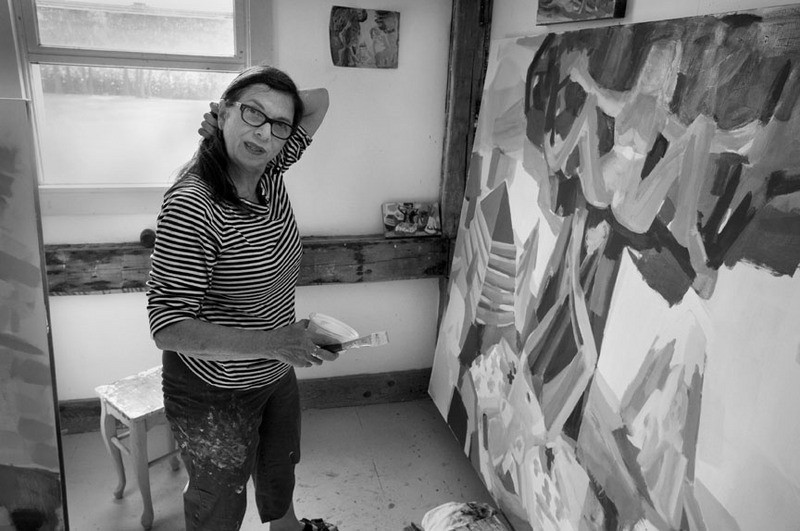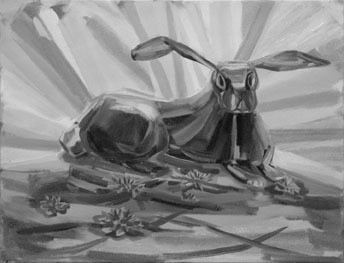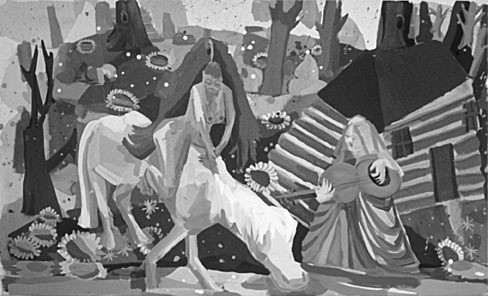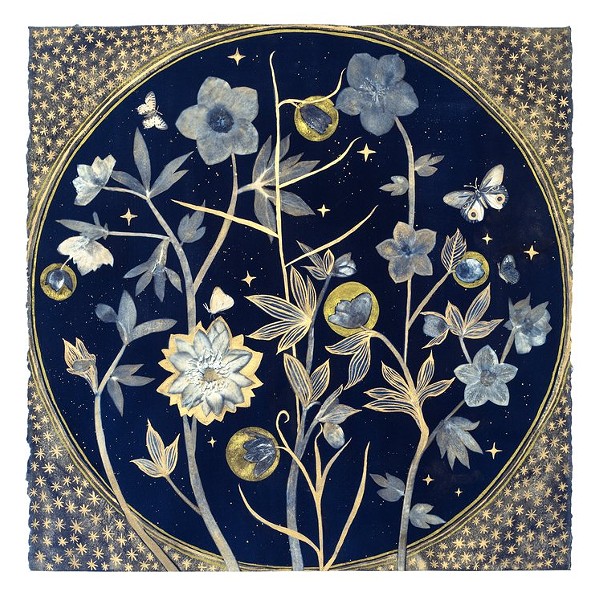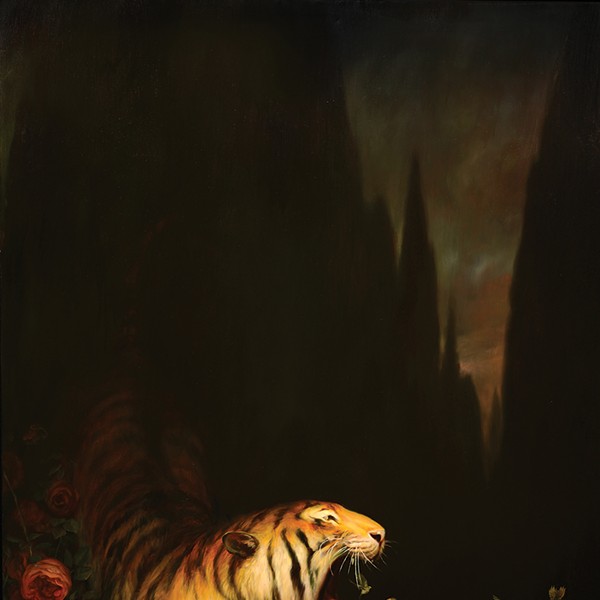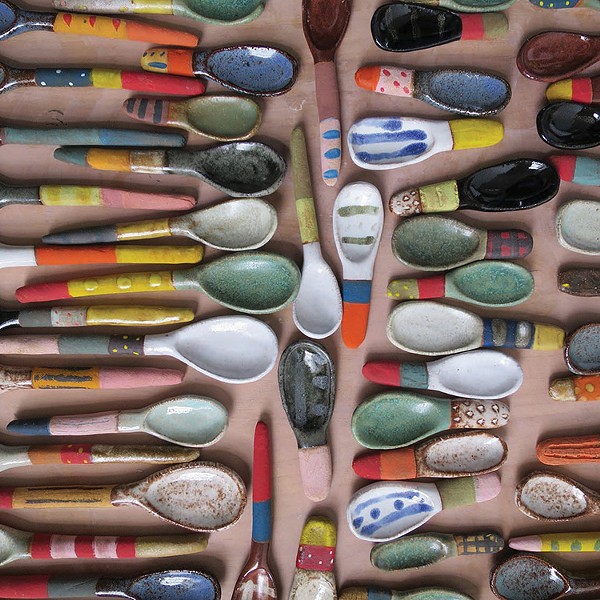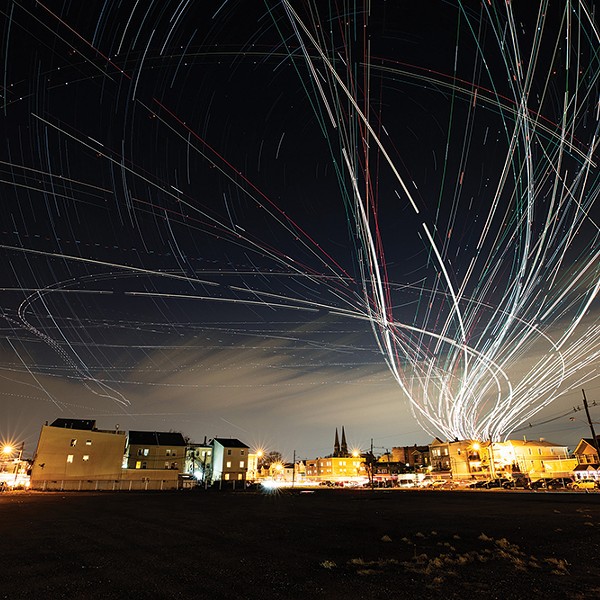From a distance, Judith Linhares’s paintings are pure candy-coated fantasies. The colors strike you first, pinks and purples, phosphorous greens, aqua- and ultramarines. Nothing is the color it should be, if by should you mean the palette of the natural world. Linhares is too busy creating her own reality to take dictation from the everyday. Or maybe she’s memorized some secret text, the channeled dreams of Minoan dryads, perhaps, or the chronicles of a forgotten faerie saga. There is a gleeful naivete to her pictures of women inhabiting forests and seasides, an innocence that reveals a deep playfulness governed by freedom, abandon, ecstasy. Linhares’s women, like her colors, break every rule of propriety, not out of defiance, but with childlike, original-face innocence. They gambol and cook and ponder in unselfconscious nakedness, clothed in joyful sensuality, often on their backs or in other sexually submissive positions. For all their hedonistic oblivion, though, there’s a knowingness in each woman’s expression, and nary a distressed damsel in sight. The Aegean queen daydreaming in the surf, the hag playing the guitar, the voluptuary watering her horse, the she-imps swinging from trees—each displays an inborn inner strength, a wellspring of hardheaded mystical insight.
In New York, Linhares has the devoted following of a painter’s painter, an artist other artists, including younger artists, draw inspiration from. In 1978, she was part of the celebrated “Bad Paintings” exhibition organized by Marcia Tucker, a show famous for its conglomeration of painters flouting aesthetic virtue in favor of expressive vigor and individual voice. The show conferred a measure of notoriety on each of its participants and, in Linhares’s case, finally convinced her to move from her native California to New York, where she has lived, taught, and painted ever since. During the summer, she and her husband relocate to a restored farmhouse in the Schoharie Valley, a homestead surrounded by oceanic fields of corn. There, she paints daily in an outbuilding converted into a large studio drenched in light from windows on two sides. Small preliminary paintings hang tacked up everywhere, and a series of half-finished canvases leans against the walls. Linhares mixes her colors in individual containers and, one color at a time, goes from canvas to canvas—a brush stroke here, a swath of pigment there—working several pictures simultaneously, like the chess sharps in Washington Square Park who take on five opponents at once. Watching her move with such deft confidence, you see where the savvy of her painted women comes from. In that regard, every one of her pictures is a self-portrait. Selections of Linhares’s work are on view at the University Art Museum at the University at Albany’s uptown campus. “Judith Linhares: New Work,” curated by Great Barrington poet and gallerist Geoffrey Young, is on view through September 30. (518) 442-4035; www.albany.edu/museum.
JUDITH LINHARES ON HER WORK
Process
I like to keep moving, keep making the work. Not let my head get ahead of my hand. I do lots and lots of gouache studies. It starts out very abstract. I just start putting down color and shapes, and they suggest an image to me. Then I develop the image. But I’m very suspicious of having a brilliant idea in my head and translating that to paint. There’s something that has to happen simultaneously. Otherwise I’d just be illustrating notions out of my head. It’s a long process, and I keep these studies going in all kinds of forms. I’m kind of rehearsing what I’m doing. It’s a matter of internalizing the image, of practicing it, so when I go big, I know a little more of where I’m going. There’s something in the repetition where other things start to reveal themselves. You find things that wouldn’t have just sprung out of your head. I’m really looking for a very iconic image, something that you experience visually from far away, and then you see the details unfold. It doesn’t come easily.
I resisted storytelling at different times in my life, but I think I have a literary imagination ultimately, and it seems to be pretty narrative. When I was in school, it was always considered retrograde to have illusionistic space. The thrust of modernist painting was to make an object that was free of the narrative, that was purely a visual experience. And I love that work; it was my first love. But I never wanted to give up the image. So [the challenge is] how to make something that’s basically visual, that then unfolds in another way so you have a more specific reading of the image. I’m really interested in a lot of the artists of the ’50s—Fairfield Porter, who I love, Richard Diebenkorn, David Park—who in the heyday of abstract expressionism were trying to bridge those two worlds.
Light and color
My knowledge of my language, which is color and how things fit together on the rectangle, creates the story. Color is basic. That’s what I initiate first, like “I want to see violet and green together.” I just start with the color. Q: Please talk about your color. It’s light, very bright, very high key. I think about the light coming from the color. There’s modeling in the paintings, but essentially when you look at this painting [she points to a canvas in progress in her studio], you feel like the bright yellow against the dark tree and the orange figure, like that figure is being backlit. Q: You mean, similar to the way light works with watercolors, where the light reflects back through the color? No. I think of the light coming from all that yellow. Q: Oh! as if the yellow is the light source of the painting? Yes. I love the possibilities of the color. This comes out of Matisse, really. That’s exactly what Matisse is doing. He’s not modeling—he’s not making light side, dark side and that’s how you experience the light. It’s a mass of red, a mass of green. Q: You do use modeling, but your modeling has another intent besides creating mass. Yes, it’s the light. It’s the warm and cool.
Sex
Timothy Cahill: Sooner or later I’m going to have to ask you this, so we might as well do it now, since we’re standing in front of a canvas [in the studio] with two naked women, one lying on her back, the other sitting in a tree with her legs spread.
Judith Linhares: (Laughs.) Yes. Right.
It’s hard in your work for the viewer to avoid a certain explicit frontal display of female sexuality. How does that enter into the meaning of your painting?
(Laughing.) Yes. Yeah . . . hmmm. Let’s see if I can answer that.
I can’t imagine you’ve never been asked that before.
No, I haven’t.
It’s so obvious.
No. Absolutely. I think it’s getting more exaggerated in my work.
This figure in the tree—there’s one like her at UAlbany, in your painting Waiting for Horsemen.
Yes. This piece is a continuation of that painting. They’re wild women, they’re out there in the woods. Feral. And they’re kind of reveling in it. It’s such a good question. I know there’s a better answer than I’m going to give you. I think they’re witches also. Witches are associated with being a little naughty and outside proper behavior.
Waiting for Horsemen made me think of the scene in “The Crucible”—well, it happens off-stage, but everything in the play hinges on it. The group of girls is caught in this ecstatic ceremony in the woods, which involves dancing and nudity and has very strong overtones of sexuality, and they’re accused of being witches. And this witchcraft—what the townspeople are really afraid of—seems to have as much to do with the sexuality as the magic.
Right. That’s great. I did an interview with Bomb where I talked about what I feel I inherited from my family. I don’t have a family picture where people aren’t in their bathing suits or on horseback or with a fishing rod. It’s like there’s some major fantasy going on about living in nature. And at the same time, there was this zealot religiosity—my great-great-grandfather was a singing Baptist preacher. I feel like I’m an inheritor of this tension between being really repressed and otherworldly, and being a pagan, basically...I had a chaotic childhood. There was a high tolerance for irrationality and creativity. I grew up in a very permissive environment. I like to say I was raised in the forest by baboons. I was left to my own devices, if the truth be known.
And now you’re painting women who are left to their own devices. If you think about it, all the women in your paintings are pretty self-absorbed. Each one of them is in her own world.
Maybe they are. I hadn’t thought about that. (Pauses.) Yeah, that’s true. But there is a kind of tribal thing going on too.







